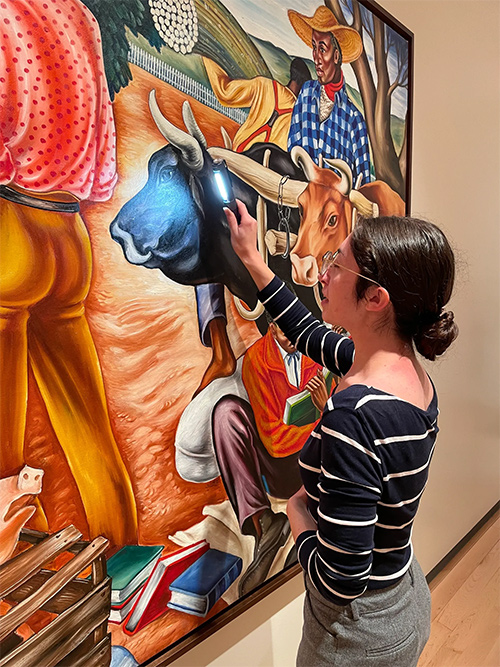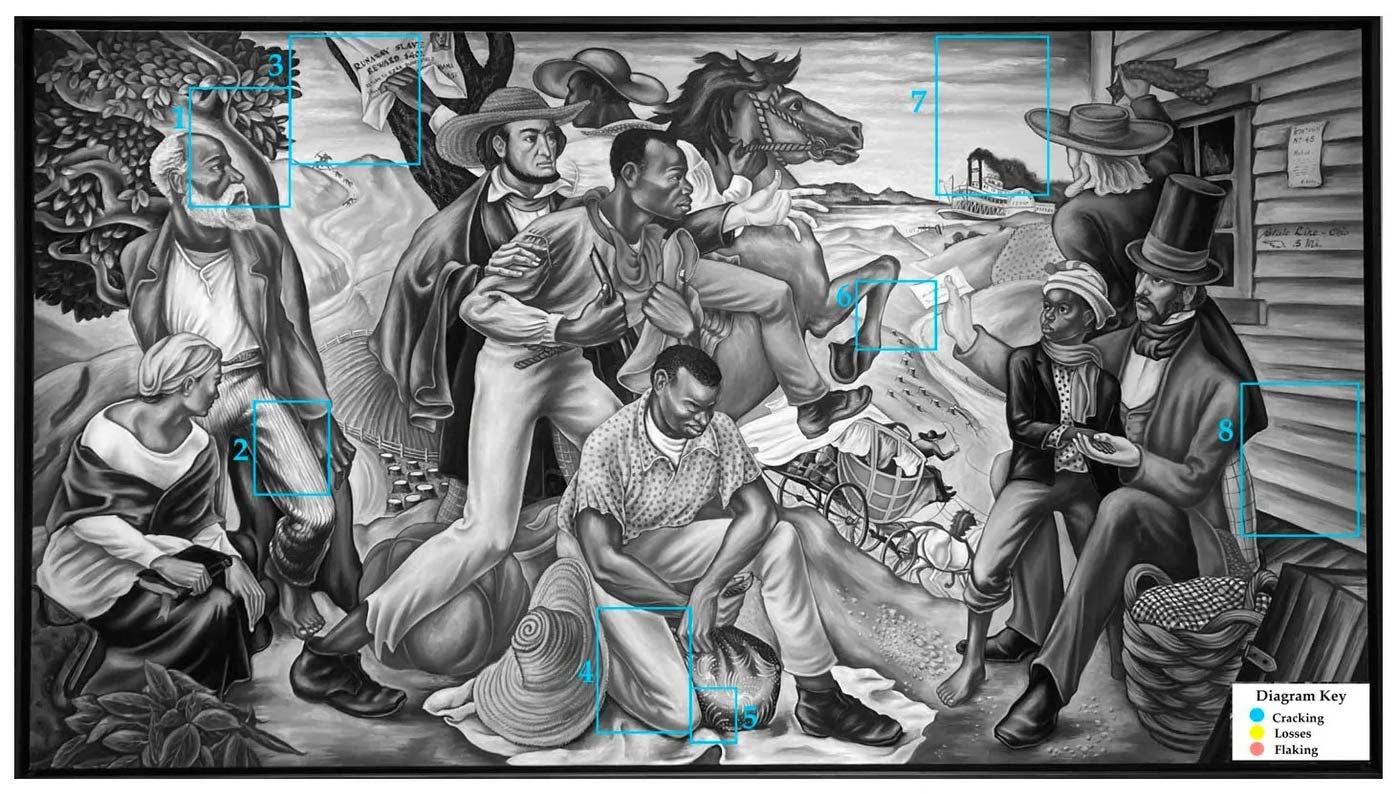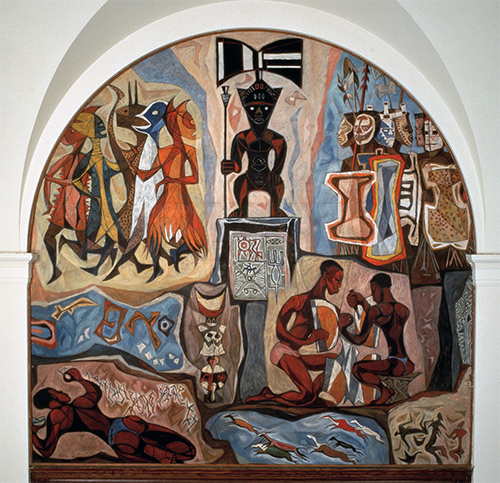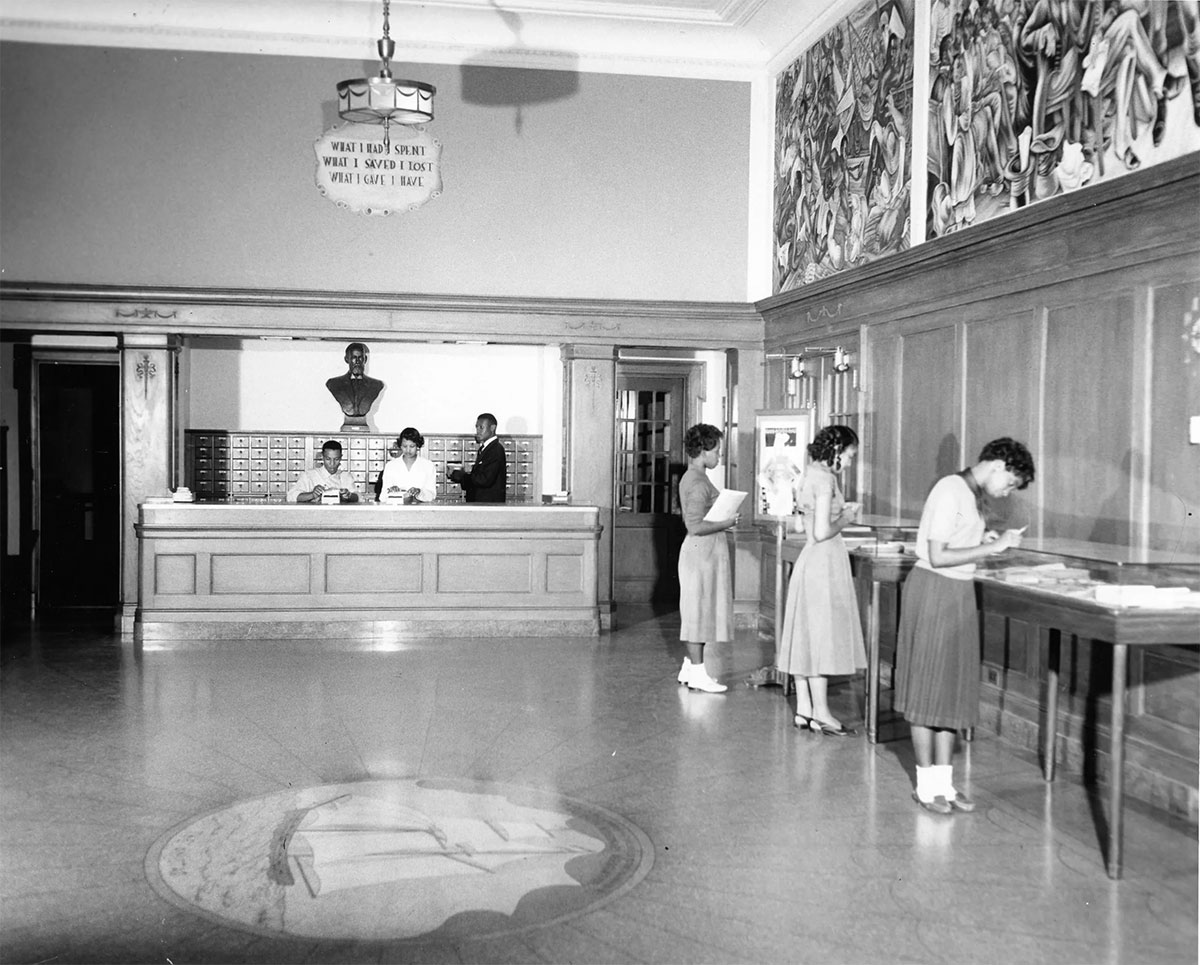



Talladega’s Amistad Murals received their annual checkup this summer when Amanda Kasman, Assistant Painting Conservator with the Atlanta Art Conservation Center (AACC), visited the galleries in June to inspect the large-scale works of Art. As part of the Museum’s membership with AACC, a conservator visits the Museum each year to thoroughly examine and clean the murals. The conservator looks for any changes in the murals or environmental conditions that need to be regulated, such as the amount of light on the paintings’ surfaces. The last time the murals were examined was in 2020 “ pre-pandemic “ when they were newly installed in the Dr. William R. Harvey Museum of Art. At that time, the conservator made detailed, color-coded maps of each mural to identify areas of cracking, flaking, and paint loss “ problems for which the eye of the conservator is trained to spot. Kasman compared her observations to the baseline presented in these maps to prepare her report.
Paintings housed in museums are typically in more stable environments than artwork in an individual’s home or office, although they are still exposed to environmental contaminants and potentially damaging conditions. Museum professionals such as curators, tour guides or docents, and gallery attendants constantly watch for any changes to works of Art and immediately report them. Every insect is a potential culprit, and fluctuations in temperature and humidity can trigger mold to develop in materials such as canvas and cause layers of paint and varnish to expand and contract, eventually leading to fine hairline cracks in the surface layers of paint. Left untreated, the cracks can deepen, eventually causing the surface layers of paint to flake away. If you’ve ever seen an old master’s painting with lots of cracks running over its surface, you’ve seen this “crazing” effect. Crazing is inevitable in most works of Art painted with organic materials, but the more stable its environmental conditions, the longer it will last.
Because Kasman was part of the team of conservators that completed the conservation of the Art of the Negro mural series at Clark Atlanta University, she was able to compare the two sets of murals in terms of materiality, painting techniques, condition, and treatment history. The two sets of murals were painted by artist Hale Woodruff, albeit at different times in history.
Woodruff was commissioned to paint the first series of murals at Talladega, The Amistad Series, in 1938; The Founding Series was commissioned shortly thereafter. Woodruff completed the Art of the Negro murals in the 1950s while he was an art instructor at New York University. The Art of the Negro murals were first conserved in the 1980s and remain in their original locations in a historic building with fluctuating climate conditions.
When Woodruff’s Talladega murals were installed on the walls of the lobby in Savery Library for its opening in 1939, environmental conditions were not ideal for the long-term preservation of the paintings. The murals were exposed to rapid and constant fluctuations in heat and humidity, occasional water leaks, ultra-violet light, insects, and cigarette smoke (patrons could still smoke indoors). But as it was pointed out by author Stephanie Heydt in Rising Up: Hale Woodruff’s Murals at Talladega College, the murals’ purpose was the centerpiece of the library’s “decorative scheme,” which also included a terrazzo floor plaque of the Amistad.
Although Hale Woodruff was beginning to attract attention as a major American artist, the intrinsic value of the murals did not reside in them as famous works of art; rather, it was in their illustrative power to visually communicate a story of Black resistance. Not until scores of Talladega College students passed quietly beneath them on their quest for knowledge and leaders of the Civil Rights Movement demanded representation in major art museums did the murals’ importance as unique, artistic objects “ “works of art” “ begin to emerge. In 2008, College leadership took action and began a process that would see the restoration of the murals and the next chapter in their history.
Kasman continued her comparison by stating that the Talladega murals are stylistically different than the Clark Atlanta murals, with thick layers of paint and visible brush strokes that capture subtle gradations of light and shadow. The jewel-toned color palette of the Talladega murals is also more vibrant than that of the Art of the Negro murals. Although both sets of murals exhibit similar types of cracking, the thickness of the paint on the Talladega murals increases the chances of cracking.
Overall, the Talladega murals were rated in good condition at their most recent checkup. Kasman took into consideration their age, provenance, history of unregulated climate exposure and material composition in determining this rating. Good condition indicates that an artwork does not show clear condition issues from a typical viewing distance. Kasman’s report also identified new areas of cracking and plans for repair, which will be instituted this fall.
The ongoing care and preservation of the Amistad murals is the primary responsibility of the Harvey Museum and Talladega College staff. If you are interested in helping to fund the ongoing conservation of the murals and other works of fine art in the special collections of Talladega College, contact the Office of Institutional Advancement.
Student Focus: Careers in the Arts and Museums
Conservation work requires knowledge of history and cultures, science and scientific procedures, materials and technologies, and much more. For more information about careers in conservation work or about conservation in general, check out this site.